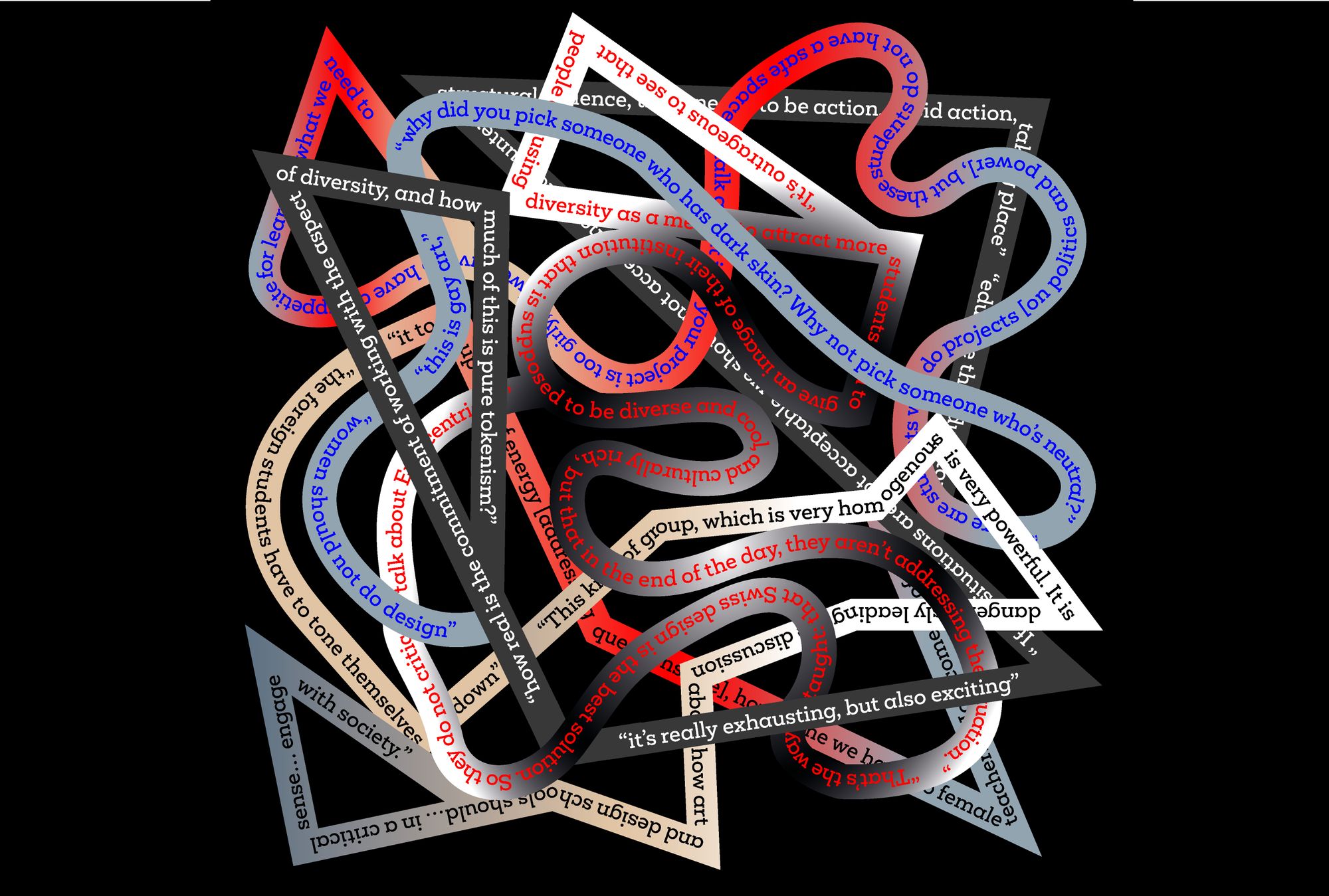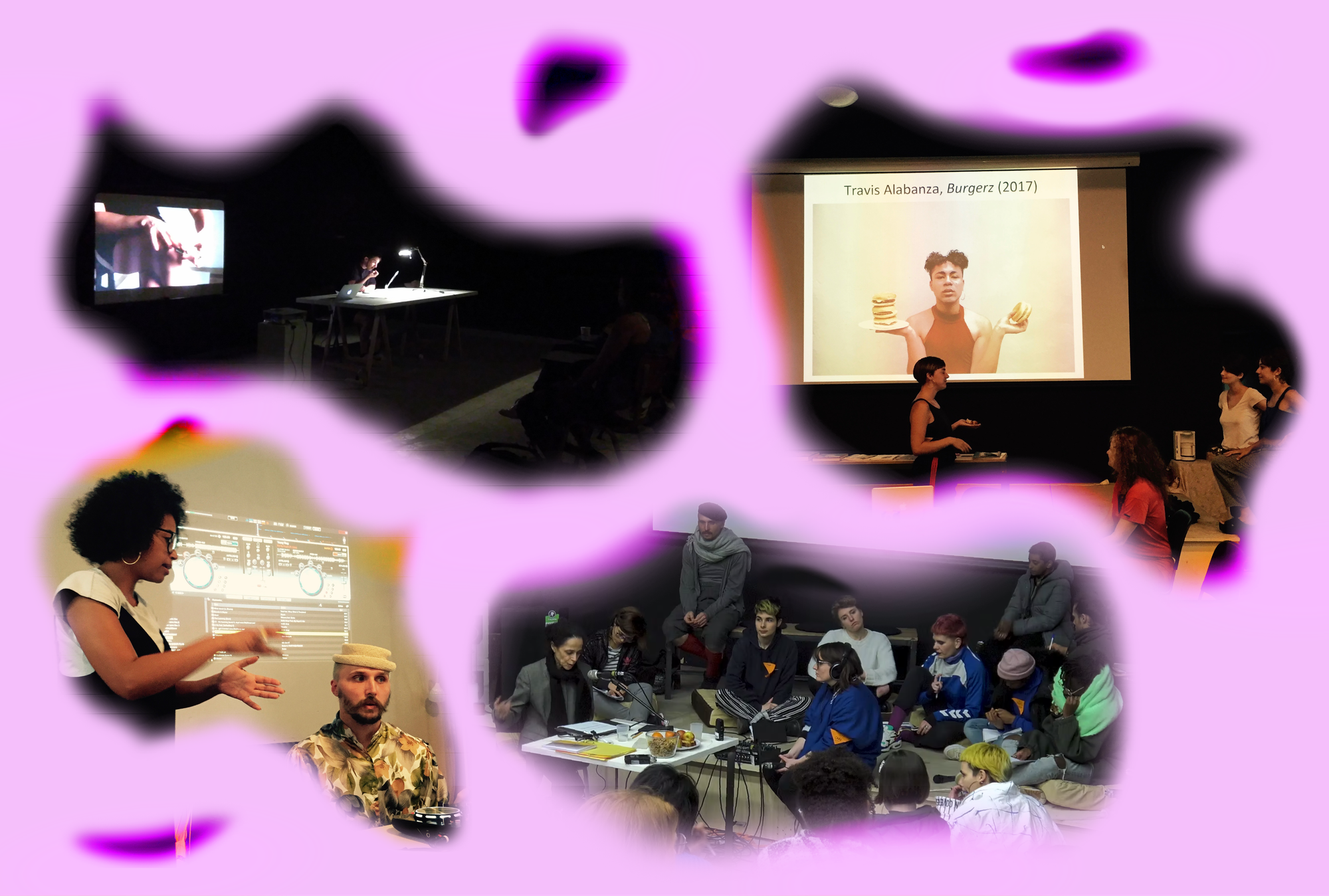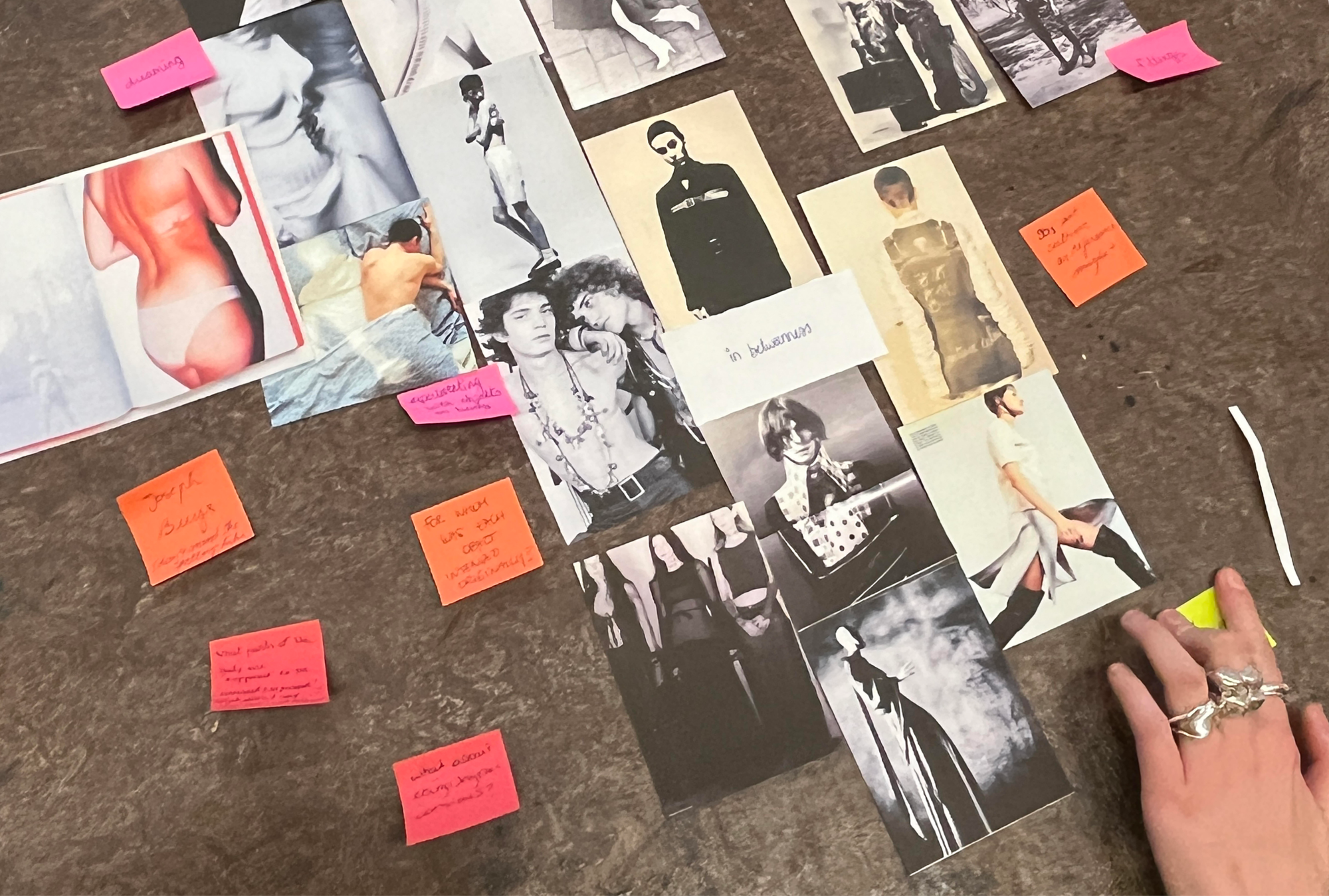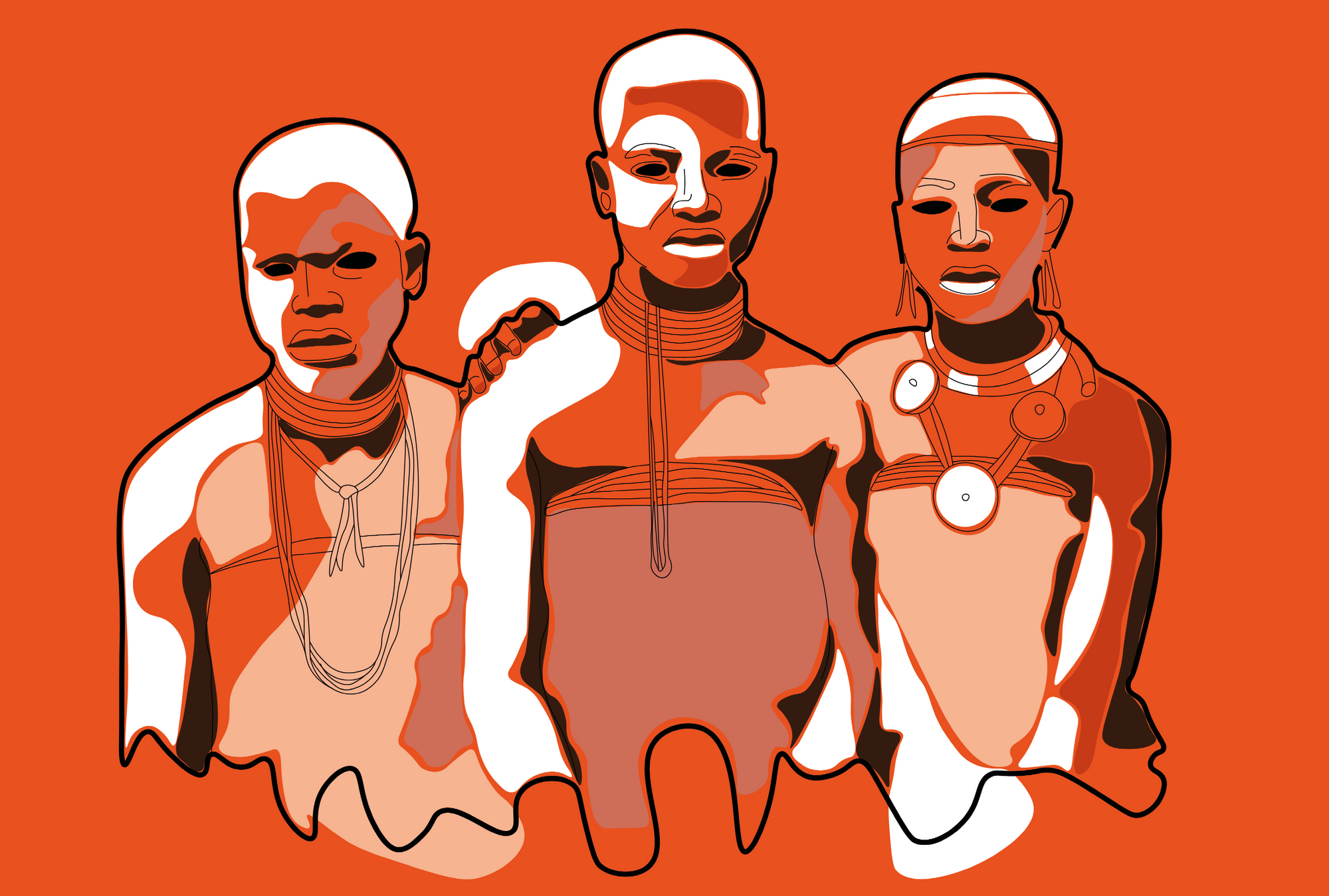
Something is afoot in design and art education. Recent months have seen a rise in students’ initiatives, open letters, social media accounts, and campaigns that address racist, sexist, and otherwise discriminatory practices and incidents of harassment at art and design institutions, including @blackatsva in the USA, @UALtruth and @GSAtruth in the UK, #exitracismUDK in Germany, or most recently @callingoutdutchartinstitutions in the Netherlands. Among them are also actions that address design and art institutions in Switzerland, a country too often left out of such discussions—be that because of its misguided belief that it is not part of colonial structures, its culture of over-politeness, or its long-held myth of neutrality both nationally and internationally. Switzerland, however, is not neutral. And neither is Swiss design or its educational institutions.
In 2016, a comprehensive qualitative study called Art.School.Differences, led by Sophie Vögele, Philippe Saner, and Pauline Vessely, pointed out that a chain of factors such as selection procedures, communication materials, limited curricula, and a general high-brow reputation of Swiss art and design have been leading to exclusionary structures at schools, which favor those from a privileged social background.
The findings were vehemently negated and harshly criticized by the three institutions that initially commissioned the study, with one of them, Zurich University of the Arts, arguing that “the acquisition of the ‘best’ means to be producing differences.” Against this self-protective tenor from the institutions, this year, students across Switzerland’s art and design institutions have been rising up and speaking out. Students at HEAD Geneva School of Art and Design and the ECAL Cantonal Art School of Lausanne wrote open letters to their departments. At the FHNW Academy of Art and Design in Basel, a group called the queer*feminist collective, which formed in 2019, intensified its efforts. And most prominently covered in national media, students in Zurich mobilized this year to demand action against one neonazi student.
These recent ground-up student initiatives in Switzerland and beyond did not materialize out of thin air. They have grown out of decades of human rights activism, community work, writing, and research. They build upon ongoing efforts from students, educators, and researchers that might not be as public, and are fuelled by recent protest movements such as Rhodes Must Fall, Black Lives Matter, #NiUnaMenos, and #metoo. And right now, the pandemic might have given them a push.
“Pandemics do not materialize in isolation. They are part and parcel of capitalism and colonisation,” wrote historian of science Edna Bonhomme earlier this year, reminding us that COVID-19 is disproportionately affecting the poorest and most vulnerable populations, and consequently accelerating global health inequality. During these difficult times, the murders of George Floyd, Breonna Taylor, Tony McDade, Ahmaud Arbery, Dion Johnson, and too many others have renewed attention on structural inequalities, ignited a global wave of anti-racist protests, and intensified calls for institutional reforms.
It is within this context that we found ourselves listening in on two remote conference calls about diversity issues within Swiss design education in September 2020. We, the authors and editors of this text, participated in organizing the event: The panel discussion was initiated by the Swiss-based research practices and activist groups common-interest and depatriarchise design, as part of this year’s national Swiss Design Awards’ alternative programming. The first roundtable featured a group of students and recent graduates, the second a group of educators.
Across the thirteen participants, there were students or staff hailing from design academies across six out of seven universities of applied sciences in Switzerland, including the FHNW Academy of Art and Design in Basel (HGK FHNW), the Cantonal Art School of Lausanne (ECAL), Geneva School of Art and Design (HEAD), Zurich University of the Arts (ZHdK), Lucerne University of Applied Sciences and Arts (HSLU), and the University of the Arts Bern (HKB). The group of students was made up of cis women, cis men, queer people, white people, people of color, one non-binary person, people from Switzerland, and people of other nationalities—all studying in Switzerland. The group of educators was largely made up of cis white women, but also included cis white men, people of color, and people with non-Swiss nationality. The thirteen participants agreed to let us report on the conversation on the condition that their statements are anonymized, to protect them from possible retaliation from within their institution or from peers.
“Right now, students at design and art schools feel the need to either become a critical mass of support, or create structures of protection to feel safe coming forward.”
No matter if it’s a formal complaint, an informal comment, or experiences assembled through a social media account, those who speak out against discriminatory structures or report harassment are often made into the problem. “A complaint seems to function rather like a switch, an alarm or alert that triggers a reaction. A complaint is how a network comes alive to protect those who are the most networked,” as feminist scholar Sara Ahmed said in a lecture earlier this year, as part of her ongoing research and qualitative interviews on complaint procedures and experiences in academic institutions. Many of the recent student actions have come up in the form of co-signed or anonymously signed letters and petitions, anonymously run social media accounts, and anonymous methods of reporting incidents through accounts. This suggests that, right now, students at design and art schools feel the need to either become a critical mass of support, or to create structures of protection to feel safe coming forward. Again, this underlines the structural issues at play, and the fact that schools must work harder to encourage students and staff to feel safer and heard when making complaints.
The following anonymous accounts trouble the carefully cultivated, internationally renowned image of Swiss design, revealing some of the daily struggles, exclusions, and false promises behind the philosophy of its institutions. While this report speaks with students or staff at six art institutions in Switzerland, the issues discussed are structural—made all the more apparent by the fact that similar experiences are being shared online by students in predominantly white, male dominated institutions. The lived experiences of racism and sexism shouldn’t be read as isolated experiences. Rather, they should be understood as systemic problems within higher education. This report is therefore not about making specific accusations or verifying individual claims, rather it’s a look behind closed doors, a listening in on discussions going on, or rather, discussions that should be going on.
I. Diversity Inside vs. Outside
One of the reoccurring themes of the two roundtable discussions suggests that while diversity is desired by institutions, the necessary structures to support the complexity of intersectional perspectives are sorely lacking. Many of the academies that we surveyed celebrate diversity and gender equity in their communication materials, and set out to welcome foreign students with open arms. “The worlds of art and design know no geographical borders, driven as they are by dialogue and diversity,” states HEAD on its website, for instance. The HGK FHNW describes that, “Diversity is a key asset… .” At the same time, support systems that would actually support a diverse student and staff body and understand that people are disadvantaged by multiple sources of oppression, due to race, class, gender, religion, ability, and more, don’t seem to be adequately supplied. “If I try to address the situation, I get comments like ‘this is too ideological,’” notes one female educator about voicing concerns about this paradox. “I feel that there’s a fear of losing privileges.”
83.3% of the top management leaders of Switzerland’s six universities of applied sciences are cis men. Five out of six are confirmed Swiss nationals (one director’s nationality could not be confirmed online). When looking specifically at the directors of academies of art and design within the Swiss universities of applied sciences, these are led by 71.4% cis men and 28.6% cis women. These statistics and all following ones are based on information found on various universities’ websites, as viewed in September 2020. Gender has been based on the pronouns used on these websites to describe faculty members. When not available on university websites, pronouns found in interviews or personal social media accounts were used. When looking at the portrait photographs of the heads of the Swiss academies of art and design on their website during the roundtable discussion, an educator of color says that these directors have a “super-narrow understanding” when it comes to the experiences of those who do not identify or look like them—and “they make their decisions based on their own experiences.”
The above numbers do not reflect the country’s population which, according to national data, is made up of 50% people assigned female at birth. What’s more, according to last year’s census, a quarter of the permanent Swiss population are of EU or non-EU nationality; in the cantons of Geneva and Basel specifically, the numbers are higher, at 40% and 36% respectively.
According to the roundtable participants, the homogenous make-up of leadership permeates the rest of their departments’ staff too. One HGK FHNW student says there are “no BIPoC” teaching in their department. At ECAL, a student describes having personally only had “one female teacher,” and a student from ZHdK notes “only one teacher of color” taught them. HSLU is described by an educator at the university as “not diverse” with higher positions “dominated by men.” In regards to race, these statements cannot be corroborated by the authors of this article, as to the best of our knowledge there is no statistical data regarding the ethnicity of the faculty. The writers of the report didn’t have sufficient resources to conduct such a study. In regards to gender though, these observations can be corroborated by numbers: According to research by common-interest and depatriarchise design, at HGK FHNW, 93.8% of heads of design majors at both bachelor and masters level are male. 83.3% are male at ECAL. According to their findings, 0% of leadership positions in design majors are held by staff outside the gender binary. When looking specifically at the teachers of visual communication at BA level, at ECAL, 19.4% are female, at ZHdK, 20%, at HGK FHNW, 16.7%. Across all the BAs of visual communication that were surveyed, HSLU is the most inclusive of female teaching staff, with 27.8% women teaching.
During the roundtable, the students expand on the ways in which this staff homogeneity, and thereby this “super-narrow understanding,” impacts them and their cohorts on a day-to-day basis. They describe concrete ways in which they feel their own needs, as determined by their identities and lived experiences of racism, sexism, and cis-heteronormativity, are not met by their respective schools.
“I personally would often feel uneasy... and I couldn’t really describe why. And then I realized it was because I was the only woman in the room, with ten men who all looked the same.”
“I personally would often feel uneasy during jury presentations, and I couldn’t really describe why. And then I realized it was because I was the only woman in the room, with ten men who all looked the same,” says one female student. A foreign graduate from a very “international” MA class describes how “the foreign students have to tone themselves down all the time, [we] feel this on a daily basis.” Generally speaking, Swiss culture is known to be reserved and has its own culturally determined understanding of politeness; there can be a palpable lack of understanding and empathy when it comes to cultural differences in communicating.
Another describes how “questions of class” are rarely addressed by their institution, with non-Swiss students taking on “side jobs to be able to stay in Switzerland.” The country’s major cities are currently ranking among the ten most expensive places to live worldwide. At the same university, the student says there are “scholarships for Swiss students but no scholarships for foreign students.” Heavy competition, a demanding atmosphere, and a general sense of discouragement towards part-time work puts pressure on those who need financial income to survive. One student with a low-income, migratory background states that the specific support for non-Swiss students without financial security is especially lacking. “Those who are studying art here that are foreign, they already have the possibility to study, the ability to live in Zurich, to have money to eat,” they say. This particular student received various scholarships during their studies, but typically for non-EU students studying in Switzerland, the semester fees are higher than for Swiss students: 714.3% more so at HGK FHNW for non-EU passport holders, 169.4% more so at ZhdK, and 200% more at SUPSI, for instance.
All the while, it’s apparent that many of the academies of design seek to attract international students, as they explicitly express in marketing copy. HEAD, for instance, describes itself as driven by “diversity” and welcoming of “exchange students from all around the world” as a contribution to “the diversity and richness of the campus.” Another, HKB, profiles itself as an “international multilingual university with students and staff from over 30 countries.”
In all this, language plays a powerful role. As one roundtable participant remarks, the “two most diverse programmes” at their school are “offered in English.” For those that don’t have a Swiss native tongue, this choice is profoundly meaningful: with currently around 1.5 billion people speaking English worldwide, out of which only one quarter are actually native speakers, English has become an important bridging language, in Europe and beyond. English has become the main language of business, science, international relations, tourism, but also of much broadcasting and cultural production. “Choosing between learning English first or German, I chose English, because I can then speak with more international people,” says one graduate in the roundtable.
However, as a non-Swiss student in a department with “people from everywhere” describes, they were personally extremely disappointed and discouraged to find that when they arrived, many of the courses were actually taught in German. “I noticed that this year, the new class is entirely Swiss German speaking,” they say. “So after ‘diversity,’ the teachers just seemed to have said, ‘we don’t want to speak English. We don’t need all this mess.’” During the roundtable discussion, a teacher from a different school seems to corroborate this sentiment: “No one is questioning the fact that we are all using a language that is not ours anymore,” they say. While it might be less comfortable for professors, language, of course, has to do with accessibility.
Students who enrolled at a school because it was offering a course in English describe their experiences with language accessibility—how it can be “a type of battle,” how their individual needs are not met, especially after being brought in on the assumption that they’ll be able to converse in English. “I was in the only bilingual programme offered by my school,” says one student. “I did not feel included in the rest of the school’s [ongoings].” Another student describes how documents were circulating in their school about diversity—but ironically, this material was only written in German “and I’m not a German speaker.” “There is a website at my school that lists all the stipends and grants you can receive, but if you don’t speak German, it’s not so easy to find online,” adds another student who is not Swiss, and who relies on grant funding to be able to study full time.
“Sometimes I wonder,” says one student, “how real is the commitment of working with the aspect of diversity, and how much of this is pure tokenism?” As one student says, “I chose to go to apply to my school because I saw a presentation in my home city that made it look international and therefore exciting.” But now that they’re a graduate from this school, they’ve observed how a Black friend is frequently asked to feature in the institution’s publicity photographs, pointing out an example of tokenization.
“Sometimes I wonder, how real is the commitment of working with the aspect of diversity, and how much of this is pure tokenism?”
An educator shines a light on the behind-the-scenes of diversity conversations at their particular school, and how old-fashioned the institution can be in regards to issues of identity. “Of course our institution has a department for diversity. But it shows us a video clip, and it’s in Swiss German,” they say. “I understand half of it… It’s mostly about very traditional heterosexual models, asking questions like, ‘what do you do to deal with equal salaries between men and women?’ So it’s still at that level. It’s something, a good start, but only a very small part of the problem.” This quote suggests that there can be a tendency to cater to cis women only, and therefore the needs of trans students and those who identify outside of the gender binary are not accounted for. The roundtable participants further suggest that at some institutions, diversity is often thought of only in terms of gender; intersecting issues, such as race, class, ability and more seem not to find themselves as represented.
One student tells us of a conference around design, politics, and activist actions that’s taking place at their institution: all of the invited speakers are white and able-bodied. Another example brought up is one school hosting a week of talks around the topic of inclusivity, talks in which “the gender binary is kept upright,” says the student. This renders non-binary or genderqueer individuals invisible within the institution.
The students in the roundtable are concerned that “diversity issues” are increasingly becoming a performative trend for art schools to tout, but that these schools then don’t address these issues within their structures. Structural change, for example, might mean developing anti-discrimination guidelines and reporting mechanisms, or instating affirmative action policies to increase the diversity of the teaching body.
“Now with the trend about decolonisation too, everyone is using the term, but not going deeper,” says another student, “Like with diversity, they use [the term], but in the background, they don’t want to change.” Two students describe projects involving countries outside of Europe being “exoticized” by their schools, and getting pushed and promoted by schools’ press departments. “But they then won’t make the efforts to invite panellists, or teachers, or people who are actually concerned by [the projects’ themes],” they say. “It’s outrageous to see that people are using diversity as a means to attract more students and to give an image of their institution that is supposed to be diverse and cool, and culturally rich, but that in the end of the day, they aren’t addressing the situation.”
II. 100 Signatures, and Counting
In June 2019, at the time of Switzerland’s national Womxn’s Strike, the largest political demonstration in the recent history of the country, a group of anonymous students sent a list of demands to a prominent design school in the country.
Their list of demands included the use of gender-equitable language, the implementation of all-gender toilets, diversity of staff and teaching contents, a family-friendly campus, a plan to prevent gender violence, and training staff in how to fight against sexism, racism, ableism, and anti-trans and anti-queer discrimination. They demanded “competent and trained confidants for people who experience discrimination,” for instance, as well as a diversity department with several experts. An involved participant tells us that they formally sent the demands to the school by post, with “over 100 signatures” of support.
After some time, “there was no reaction to it,” so the students say they followed up and continued to do so when met with no responses. By “3 March 2020, there was still no reaction.” And as of the writing of this report, they say they still haven’t had an official reply. Now with a change in leadership at the school, the process has to start again.
One of the student signatories of this letter is also in our roundtable. As a particular grievance, they mention a problematic poster exhibition held at one school’s entrance hall, which featured “content of pure racism… shown without any context at all.” A teacher seems to refer to the same exhibition in the second roundtable, describing it as “clearly show[ing] sexist and racist images or designs.” Other students voice further grievances: out of the seven students speaking to us, six say they have witnessed and/or experienced racism or structural violence first hand.
Two out of the six students say they have personally experienced sexual harassment at their institution. “There’s a lot of harassment from staff to students,” notes one participant. Another describes being shown sexualized images during a public presentation, and an invited lecturer who “asked a student for their phone number,” amongst other inappropriate remarks and actions. One student tells us what their fellow classmates heard from their teachers: “Women should not do design,” “this is gay art,” “your project is too girly,” “why did you pick someone who has dark skin? Why not pick someone who’s neutral?,” “you should dress like this more often.”
“Students discuss feeling muted when they address these problems with their institutions, which raises the question of how and where they can be addressed at all.”
Another student describes a “clearly racist attack” that they witnessed, where a teacher “questioned [a student’s] cultural identity” in a public presentation. A different student describes a field trip to a Southern European country, where a teacher remarked in advance to “take notice because there are poor people there.” A third student remarks that racist or classist remarks for them are “a type of normalisation in Switzerland,” and “a reality” for those “from different places.” One of the students bemoans the lack of a “space for exchange or events” that deal with discrimination at their institution, as well as the lack of “psychological support.”
Both students, and a female staff member, discuss feeling muted when they address these problems with their institutions, which raises the question of how and where they can be addressed at all. “Any time we’ve tried to speak up about [inclusivity], we were told that we’re doing sociology… [that] it had not anything to do with the school,” says one student. This statement echoes one female teacher’s remark that when she addresses gender issues in her department, she receives answers like, “but we are not gender studies.”
When these conversations are excluded from design education, institutions not only express indifference towards their students; they perpetuate the problematic myth that design is supposedly neutral or objective.
III. Educating the Educators
Design is a powerful tool: it’s persuasive, and its messaging and histories are, of course, never neutral. The power of design, of aesthetics, of marketing, comes with responsibility for those who are able to wield its influence—design impacts how people perceive a message or perceive one another, and therefore, it’s always political. Given the apparent apathy to addressing issues of power and privilege on a structural level, it’s perhaps not surprising that the roundtable students studying visual communication or graphic design specifically say that the politics of design is rarely—or never—addressed in their curricula.
The roundtable’s students are asked how issues of design and race, gender, class, ethnicity, sexuality, ability, and more are discussed, if at all, in their departments. An MA student of visual communication states that the political “questions of identity are not present” in their course. A BA student at the same school says “if one is interested in critical discussions, one [generally] needs to look for them,” though they do applaud one “great” queer feminist theory class they attended. “Swiss design is a massive thing, and the idea of the universal,” they say. “That’s the way it’s taught: that Swiss design is the best solution. So they do not critically talk about Eurocentrism.” The problems of such an approach have been widely criticized for decades, and in the current moment appear ever more conservative and out of touch.
One MA student says there is “completely zero” education on power and privilege in their course. “From my point of view, it’s what you would imagine if a bunch of privileged white men would run a place: [they] don’t talk about anything that is uncomfortable,” they say. During the teachers’ roundtable, one white, male educator describes how the dominance of white men in leadership positions also permeates what and who is taught in the classroom: “the school has an ego and a super-ego, and the two of them are dominated by traditions and by a history of the field, which is white male dominated in the orthodoxy.” A second educator adds: “A lot of [our] teachers in theory come from German-speaking countries, which comes from a very traditional, hardcore [understanding] of how humanities, design thinking, and artistic thinking, should be,” they say. “This kind of group, which is very homogenous, is very powerful. It is dangerously leading the discussion about how art and design schools should… in a critical sense… engage with society.”
“Design is a powerful tool: it’s persuasive, and its messaging and histories are, of course, never neutral.”
The students all note that while their curricula don’t offer the level of criticality that they would hope for, that doesn’t mean that there aren’t critical questions being forefronted in their various departments. According to them, politicized questions are present, but they’re coming from the students, not the institutions. “There are students who do projects [on politics and power], but these students do not have a safe space to talk about it,” one student asserts. Another describes having attended the final exhibition show of their school for nearly a decade, and how “maybe half of the graduating projects will talk about gender, about race.” “The school does not encourage it,” they continue. “It tells the student that these are problematic subjects and there is no need to get into that.”
Judging from their conversation, it seems that students are educating themselves on anti-racism, on anti-sexism, on anti-ableism, on privilege and power. “Many things that I learned about privileges, I didn’t learn from school, but from people fighting oppressive structures in art and design,” says one student, “and not to mention, these people are not being paid for that at all.”
A couple of the educators also recognise that students are the ones first bringing the topics of power and privilege to the table: “Many of our students know much more about the discourse, and have already internalized it,” says one teacher. Students “advance way faster than the structure of the school itself,” acknowledges another, “it’s about how to create a dialogue and connection between those two bodies of people… in order to bring structural change.” The same teacher pauses, then adds, “it shouldn’t only be the students to do that,” making reference to the emotional labor of speaking out against power.
The educators at the roundtable acknowledge that students seem to have answers to issues of diversity in their schools, despite the fact that ensuring an accessible, barrier-free, and anti-discriminatory environment should not be their burden to take on in the first place. It’s abundantly clear from the roundtable that students have ideas for how their institutions could address diversity seriously and effectively.
“We have to hire new staff that are directly concerned,” emphasizes a non-binary student. “We have to have members who are gender non-normative or non-white, who are disabled, who have the experience to talk about the things that we’re actually teaching, so that we’re not simply looking pretty or attractive on paper.” On the topic of recruitment, an educator also noted: “it is something to be thought both on the invitation level for workshops and conferences, and then for permanent staff.”
It’s vital to consider not only general equity in staff, but equity across contract types and positions. For example, at HGK FHNW, 63% of the staff teaching on the visual communication course are male. Break this down further, and the inequity in contract types becomes clear: 84.2% male tenured professors and senior lecturers lead the visual communication classes, and then 87.5% of the mid-level academic staff (including researchers and post-doc fellows) are female. These women are presumably on the standard Swiss limited five-year contract, unlike their male counterparts on the permanent contracts of tenured professors and senior lecturers. When in a more precarious situation, it makes it more difficult on a personal level to push against the grain for institutional change.
When asked how their institutions could do better, one common theme emerges from the students: “educate the educators,” a few of them say. “My advice is when students have a immigration background, universities have to really think about these people,” adds a student—suggesting educating teachers on the obstacles faced by foreign people in the country. “Why are they here? What is their accessibility? Who is supporting them in the background? What do they do for work besides their studies?” One of the teachers in the educator’s roundtable echoes the students’ sentiments: “We have to have an appetite for learning what we need to change in our own classes.” Again, it should not be the responsibility and labor of students to educate the educators—but right now, it does seem to be that this work is largely being placed in their hands.
“For me, being vocal, as students and staff, is one of the best things to do,” says one student. “It’s the responsibility of each one of us,” says another, later adding: “If the situations are not acceptable, we should not accept them—to counter structural violence, there needs to be action, rapid action, taking place.” And rapid action is already taking place, as we saw first with the aforementioned 2019 letter. As was hinted at in the introduction to this report, this year, during the summer’s Black Lives Matter protests, an urgent open letter sent to HEAD written by students, alumni and assistants called for institutional reform, and an end to “an internal xenophobic and discriminatory dynamic.” And a few months ago, a letter addressed to ZhdK and written by students and alumni demanded measures be taken by the institution against a neo-Nazi student behind anti-Semitic sticker campaigns and Zoom attacks.
“If the situations are not acceptable, we should not accept them.”
One student describes that at their institution, a group of female students recently pushed their university to hire a mental health counsellor and address issues of sexism at a structural level. “All the work was done by the mostly female students,” they say. “It took up a lot of energy [addressing questions like], how come we have no female teachers? How come all of our classrooms, except for one, are named after men?”
Asking these kinds of questions to people in positions of power—gatekeepers with access to jobs, letters of recommendation, and more—takes a lot of strength. It’s not easy. A teacher from the same school also spoke of the power of these particular students’ brave actions: “They used the space of their thesis… [and] transformed it from an educational exercise into something that is way beyond the merely academic… into something that reflects on the issues of gender inequality in the school.” Hearing of this project, another educator adds: “There is a possibility for interventions, visible interventions, in this space of the school, and in a public way. This is also the relation between design and activism.”
At the end of the conversation between the educators, one teacher suggests all meeting again remotely in a few months’ time to continue discussing what can be done to address “diversity issues” at their institutions.
The rest of the educators seem to politely agree, but the atmosphere is a little reserved and distant, especially due to a problematic comment made a few minutes prior—one in which, unprompted, a white educator accused a past student of “making up” that they were given a bad grade because of racism. In the context of the conversation, this comment felt particularly defensive and questionable: are we not to believe the experience of students, especially students from historically marginalized backgrounds, students who can feel the intense emotional violence of discrimination in a way that those without the same lived experience can never imagine? Unconscious racist bias prevails in society, and educators, if not trained, are not absolved from those biases. This moment in the call, a very fleeting yet heavy one, provided a glimpse into what conversations might sound like among an institution’s faculty behind closed doors or when a concern is raised by a student.
At the end of the conversation between students, each of the seven participants smilingly promises to find one another on social media. There’s a sense of hope and energy in the Zoom space. They’ll add one another to social feeds, they’ll keep talking, keep swapping stories, keep sharing strength and advice. There’s a sense of something building, a shared space to talk about difficulties and struggles together, and connect with like-minded individuals beyond their separated institutions. Speaking together feels like a first effort, a first step, towards something meaningful and activating. As one roundtable participant says, “it’s really exhausting, but also exciting.”
depatriarchise design is a non-profit design research platform working across different mediation formats. Its manifold investigative and activist practice is rooted in intersectional feminism. depatriarchise design contributed research and editing to this article, and have also co-published the piece. An earlier version of this text was also published in the accompanying publication of the 2020 Swiss Design Awards, titled Failure Is Not an Option.
The title of this vertical, Complaint Collective, is an homage to Sara Ahmed, whose ideas have been and continue to be extremely influential to Futuress. In killjoy solidarity, we stand!















